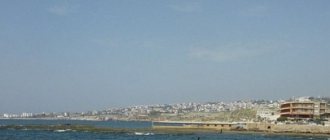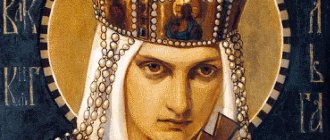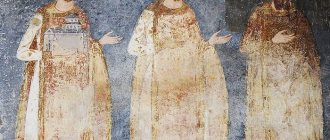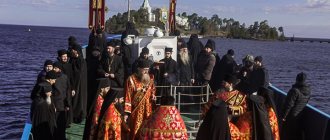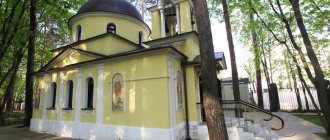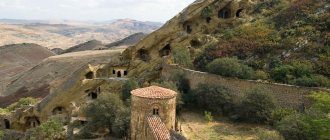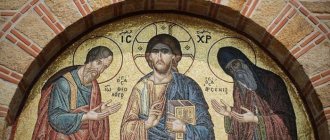June 21 old/July 4 new:
The Reverend Confessor Georgy (Lavrov) in the early 20s of the twentieth century was a resident of the Danilov Monastery and was revered as a famous Moscow elder. He was a pupil of the Optina Hermitage, then the abbot of the Meshchovsky Monastery. According to the priest’s stories to his spiritual children, in 1918 he was arrested and sentenced to death and only miraculously escaped death. In 1920, Father Georgy was serving a sentence in Taganskaya prison in Moscow. There he learned basic medical skills and, as an orderly, helped other prisoners, while secretly confessing to prisoners.
At the same time, many bishops were in the Tagansk prison, for example, Metropolitan Kirill (Smirnov), the rector of the Danilov Monastery, Bishop Theodore (Pozdeevsky) and others. Metropolitan Kirill, seeing in Father George a clear gift of God for the consolation of the suffering, blessed him to become an elder. Vladyka Theodore, after his release in 1922, took Father George “on bail” to the monastery. The priest’s obedience in Danilov was confession.
The rumor about Danilov’s loving confessor quickly spread throughout Moscow. On weekdays, in a small church on the first floor of the Church of the Holy Fathers of the Seven Ecumenical Councils, and on holidays - in the Trinity Cathedral, near the shrine with the relics of the Venerable Prince Daniel of Moscow, Father George received the “mournful Moscow people, flowing like a river into a cherished corner of consolation.”
Both the common people and the intelligentsia - doctors, engineers, actors, scientists - resorted to the spiritual guidance of the priest. At every service there was a long line to see him for confession. Many young people began to visit Father George. Archimandrite Georgy attracted people to himself with his kind and simple attitude towards everyone, his warmth, and his ability to console in sorrows and life's hardships. “Father George taught us to be attentive to people and diligently fulfill our family and official responsibilities. He demanded from spiritual children constancy in faith and daily prayer, albeit brief when necessary, but attentive and sincere, and proof of faith by good deeds. “I always said that it is necessary and possible to be an ascetic in everyday life,” recalled one of Archimandrite George’s spiritual children. – Father advised to live a working, measured, peaceful and pious life. He did not encourage empty chatter about religion over a joyful tea and said that faith must be affirmed in oneself, in the family and in others through constant good deeds combined with prayer.”
In 1928, Archimandrite George was arrested. He was accused of “playing the role of an ‘elder’ in the Black Hundred Danilov Monastery,” that the number of his spiritual children reached a thousand people, and he conducted anti-Soviet propaganda among them.” Archimandrite George was exiled to Kazakhstan for 3 years; his beloved confessor was followed by some of his spiritual children to ease Father George’s hardships of exile; many came to visit the priest, although the journey was long and unsafe.
In Kara-Tyube, the priest developed laryngeal cancer. His term of exile ended, but the authorities delayed his release. Archimandrite George died in Nizhny Novgorod, where he was brought in 1932 already terminally ill. The death of Father George was unusual. He felt relief from his illness and could talk for a long time with his spiritual children who came to him. Among them was Archimandrite Sergius (Voskresensky), who in the last minutes of the elder’s earthly life gave him the Holy Gifts. Father took the Chalice in his hands, accepted the Holy Gifts and so, with the Chalice in his hands, died quietly.
In 2000, by the Council of Bishops, among the New Martyrs and Confessors of the Russian Church, Archimandrite Georgy (Lavrov) was canonized, his holy relics were found and transferred to the Intercession Church of the Danilov Monastery.
The famous Moscow priest, Archpriest Vasily Serebrennikov, who confessed to Archimandrite George in the 20s, recalled it this way: “Father George had a special kindness, spiritual. You approach him and, no matter how worried you are, you calm down. Subsequently, I was not able to experience such confessions as those of Father George. He was an extraordinary spiritual father.” And in our time, believers have noticed that St. George helps to sincerely repent in confession, pacifies in quarrels, and consoles in sorrows and illnesses, especially cancer.
Prayer to St. George Danilovsky
O glorious servant of God, Reverend Father George, praise and adornment to Danilov’s monastery! From your youth you desired the monastic life, and having labored in it, you acquired the love of Christ; having labored in it, you acquired the love of Christ, and you were a good shepherd to those who came to you: after being exiled and enduring much sorrow, you inherited the Kingdom of Heaven. And now look upon us, your children, who pray to you, and guide our souls to salvation; Strengthen our holy monastery with peace and piety, so that through a pure life we may please God; to Him belongs all glory, honor and worship, forever. Amen.
July 3, 2017
In memory of the Reverend Confessor Georgy (Lavrov)
On the 85th anniversary of his death
Reverend Confessor George was born on February 28, 1868 in the village of Kasimovka, Lama volost, Yelets district, Oryol province (modern Lipetsk region) into the large peasant family of Dimitri Abramovich and Fekla Arkhipovna Lavrukhin. The family was of small income, Gerasim completed only three classes of a rural school.
Archim. Georgy (Lavrov)
Parents raised their children in piety. The whole family went on pilgrimage to the Trinity-Sergius Lavra and other places. When the boy was 12 years old, he and his parents visited Optina Pustyn. According to custom, the arriving pilgrims went to the Venerable Elder Ambrose for a blessing. When the mother and son approached the elder, he hugged the boy’s head, blessed him and especially noted him as a future monk. Optina made a deep impression on Gerasim. He returned to the village, joyfully remembering the monastery. Gradually, he developed a desire to go there for monastic residence, and ten years later Gerasim left his parents’ house forever for the sake of the Father’s house. This was in 1890.
At first, Gerasim worked on the economic side - in the kitchen, in the bakery, in the candle factory, in the field, and was engaged in fishing; then he passed obedience under the treasurer, then he was an assistant sacristan. In 1899, novice Gerasim was tonsured a monk with the name George (in honor of the Holy Great Martyr George). And in 1902 he was ordained a hierodeacon. He was given responsible obediences, he had to travel to Moscow, St. Petersburg, Kaluga. Father George tried to do all this carefully, carefully, trying not to sin in any detail. External labors were combined with spiritual work, with a constant struggle with passions.
It is known that he had disagreements regarding the management of the monastery with the monastery’s ruler, Elder Barsanuphius (Plekhankov), which caused a division among the monks in Optina - an event hitherto unheard of there.
In 1914, Hierodeacon Georgy was transferred to the Meshchovsky St. George Monastery and, by the Decree of the Holy Synod of October 31, 1915, was appointed to the position of rector with ordination to the rank of hieromonk, and was awarded a gait.
Archim. Georgy (Lavrov)
Hieromonk Georgy ruled the Meshchovsky monastery during the difficult times of the world war and revolution. In this he was helped by practical experience and the ability to manage wisely, acquired in Optina, kindness and wisdom in relations with people. On November 2, 1917, for his work as a rector, Father George was awarded the pectoral cross by the Holy Synod.
With the onset of the revolution, persecution of the Church began. Spiritual disasters were aggravated by local famine. There were days when there was no bread in the monastery. Father George made efforts to feed not only the brethren, but also the starving peasants of nearby villages. I sewed bags with the novices, poured flour into them, then harnessed a horse and took these bags to the poor peasants. The kind and merciful abbot was loved by the residents of Meshchovsk and surrounding villages.
In December 1918, the Bolsheviks burst into the monastery, searched all the premises, destroyed the monastery, and desecrated the shrines. Hieromonk George was arrested and accused of “secret conspiracy” and “possession of weapons.” The shepherd and a group of prisoners were sentenced to death. The elder told how, having put on his stole, he went out into a remote corridor to pray: “I prayed and cried like never before in my life.” After prayer, he received a miraculous vision - a long-dead merchant appeared to him, whose family he had once saved from ruin, as well as his deceased mother, who said that he would survive. Returning to the cell, Father Georgy consoled the arrested, saying that they would survive. And so it happened: the execution of those arrested was replaced by five years of imprisonment, which Father Georgy served in Butyrskaya and Taganskaya prisons. Six prisoners who escaped death with Father George became his spiritual children.
While in prison, Father Georgy served as a nurse and was a comforting elder for many prisoners. Father confessed and gave communion to those who wished, and tried to console and encourage everyone. Sometimes he would tearfully persuade dying people to tell him if he saw that a person was leaving from this life embittered.
Reverend Confessor Georgy (Lavrov)
In the Tagansk prison at that time there were the future martyr Metropolitan of Kazan Kirill (Smirnov) and the rector of the Moscow Danilov Monastery, Archbishop Theodore (Pozdeevsky). The virtues of Hieromonk George were not hidden from the bishop-confessors, and this was of great importance for his future life. Metropolitan Kirill, noticing in him the gracious gift of reasoning and love, blessed Father George for eldership, and Archbishop Theodore accepted him into the Danilov Monastery, taking the elder “on bail.” Being a resident of the Danilov Monastery, hieromonk and then Archimandrite George was appointed to the position of fraternal confessor. His obedience was also to accept the confession of parishioners.
Muscovites fell in love with Father George, revered him for his gift of consolation and insight. Among his spiritual children there were educated people, prominent scientists, and ordinary people; the old man was always surrounded by youth. Archimandrite George was also visited by the bishops who lived in Danilov at that time. Many of the elder’s spiritual children suffered persecution for their faith. Among them are the holy martyrs Metropolitan Seraphim (Chichagov), Archpriest Vladimir Ambartsumov, Hieromonk Pavel (Troitsky) and others. Elder George had an extraordinary gift of love, kindness, mercy, and helped people with advice, deeds, and prayer. There are many testimonies of his miraculous prayerful help to those in need.
Archimandrite George paid exceptional attention to youth. “A person’s path is formed from a young age, and then it is difficult to change it,” he said. The elder directed many young men and women to the path of faith, which in those years was confessional. The pastor rarely allowed his spiritual children to become monks, but usually advised them to study more. He believed that during persecution only people with extensive life experience could go to the monastery. However, the ascetic immediately saw the person for whom the Lord had prepared the monastic path. Trying to protect his spiritual children from accusations of creating “counter-revolutionary organizations,” Father George did not allow them to create any groups, but to testify to the faith with their lives. Often the elder gave instructions to his spiritual children in the form of sayings. “After a storm there is silence, after sorrow there is joy,” said the shepherd.
“Father George taught us to be attentive to people and diligently fulfill our family and official responsibilities. He demanded from spiritual children constancy in faith and daily prayer, albeit brief when necessary, but attentive and sincere, and proof of faith by good deeds. “I always said that it is necessary and possible to be an ascetic in everyday life,” recalled one of Archimandrite George’s spiritual children. – Father advised to live a working, measured, peaceful and pious life. He did not encourage empty chatter about religion over a joyful tea and said that faith must be affirmed in oneself, in the family and in others through constant good deeds combined with prayer.”
During the disagreements that arose due to the “Declaration” of Metropolitan Sergius, Father George convinced the brethren not to introduce divisions into the Church and remained on the side of the Deputy Locum Tenens.
In May 1928, Archimandrite George was arrested for the second time. He was accused of “playing the role of an elder in a Black Hundred monastery and conducting anti-Soviet propaganda” and sentenced to three years of exile in Kazakhstan.
Reverend Confessor Georgy (Lavrov)
Here Father George fell seriously ill - he was diagnosed with a tumor of the larynx. The elder practically could not eat; further life in difficult conditions of exile threatened him with starvation. However, local authorities deliberately delayed his release for a whole year. In the spring of 1932, Archimandrite George received freedom, but he was not allowed to go to the capital even for surgery. He spent the last months of his life in Nizhny Novgorod. The death of Father George was unusual. He felt relief from his illness and could talk for a long time with his spiritual children who came to him. Among them was Archimandrite Sergius (Voskresensky), who in the last minutes of the elder’s earthly life gave him the Holy Gifts. Father took the Chalice in his hands, accepted the Holy Gifts, and so, with the Chalice in his hands, died quietly on July 4, 1932.
Icon of the Venerable Confessor George (Lavrov)
At the Jubilee Council of Bishops of the Russian Orthodox Church in 2000, Archimandrite George was glorified as one of the holy new martyrs and confessors of Russia. On October 11, 2000, his venerable relics were found. Now they rest in the Intercession Church of the Danilov Monastery. The name of the Reverend Confessor George is included in the Cathedral of Lipetsk Saints.
The famous Moscow priest, Archpriest Vasily Serebrennikov, who confessed to Archimandrite George in the 20s, recalled it this way: “Father George had a special kindness, spiritual. You approach him and, no matter how worried you are, you calm down. Subsequently, I was not able to experience such confessions as those of Father George. He was an extraordinary spiritual father.” And in our time, believers have noticed that St. George helps to sincerely repent in confession, pacifies in quarrels, and consoles in sorrows and illnesses, especially cancer.
Troparion to the Venerable Confessor George, tone 2
From childhood you desired the monastic life, / Reverend Father George, / in which you acquired the love of Christ, / you were a good shepherd to many people, / after suffering exile, / you were adorned with the crown of confession. / And now, standing before the throne of the Holy Trinity, unceasingly pray // to save and enlighten our souls.
Kontakion to the Venerable Confessor George, tone 4
Armed with the word of the Gospel, / you have endured all the sorrow of this corruptible and fickle life, / comforting your children with the love that is in Christ Jesus, / St. George, Danilov’s praise, // pray to Christ God to save us who honor you.
Prepared by Antonina Chesnokova, member of the commission for the canonization of saints of the Lipetsk Metropolis
Types of icons depicting the Great Martyr
It is much more convenient to pray to a saint when there is an iconographic image of him before your eyes. Ancient and modern icon painters depict the great martyr in various images. Among them:
- A warrior on horseback defeating the serpent.
- A foot warrior with a spear and/or sword in his hands.
- Martyr with a cross in his hands (full height).
- Martyr with a cross in his hands (chest-length image).
- The saint sits on a throne, and an angel places a crown on his head.
Which image to buy is up to you. The Holy Fathers did not give recommendations on this matter, so the choice depends solely on your preferences. Orthodox churches around the world contain shrines of various iconographic types, and they are all equally revered.
Do you want to purchase the icon of St. George the Victorious? Such thoughts indicate a desire to pray more often to a saint dear to his heart. Don’t put off your purchase for too long: order the image of the great martyr and pray to him at any time of the day!

